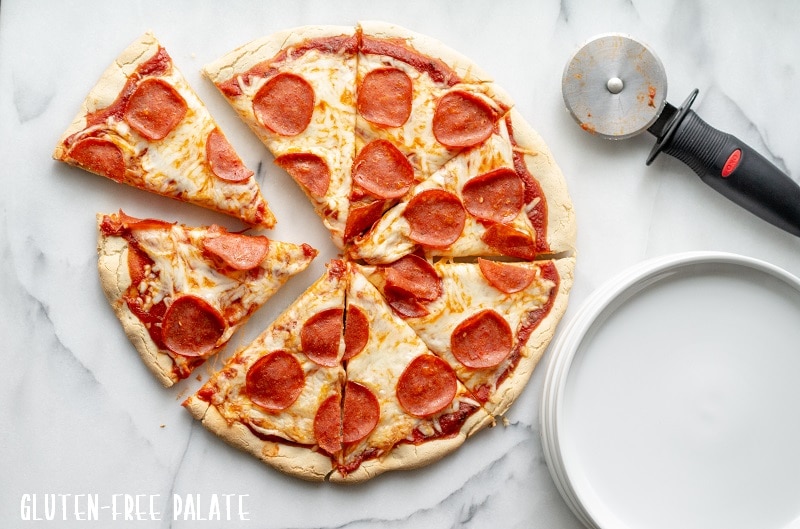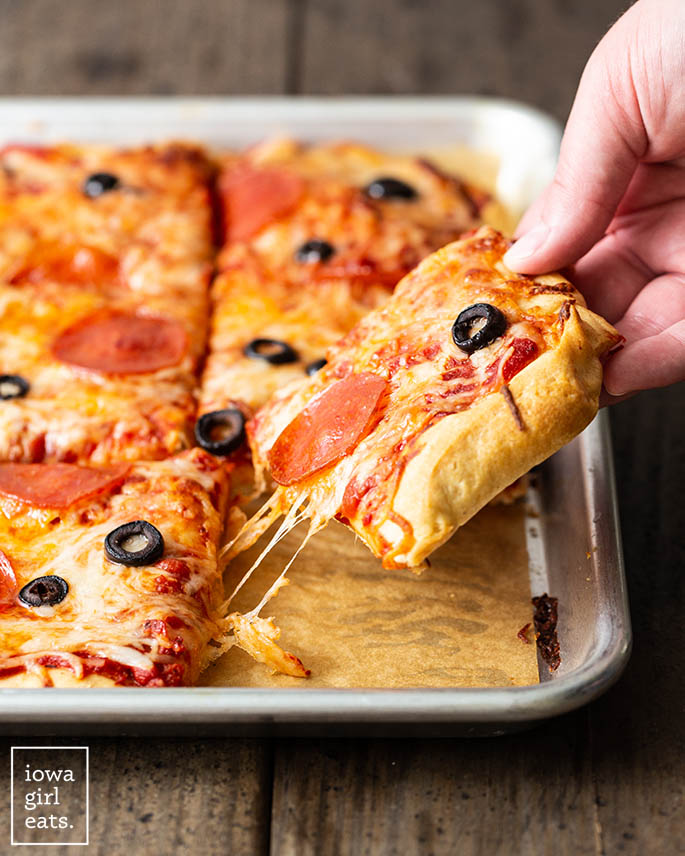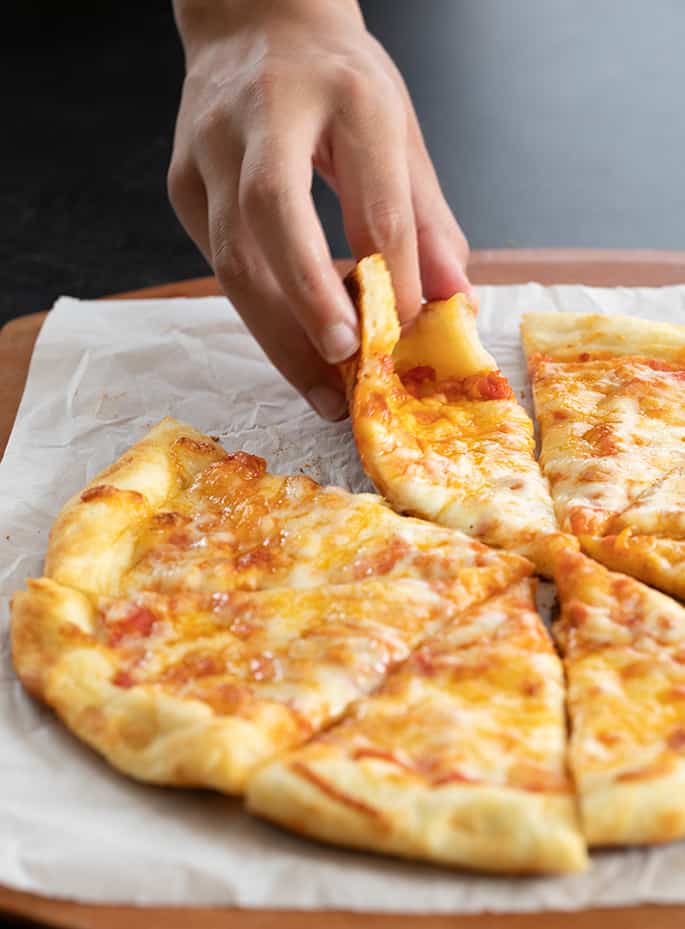
How to Make Gluten Free Pizza Dough: Quick & Tasty Tips
To make gluten-free pizza dough, mix gluten-free flour, yeast, warm water, olive oil, and xanthan gum. Stir until the mixture forms a dough, then knead gently for a smooth texture.
Creating a delicious gluten-free pizza dough is simpler than you might think, opening a world of culinary possibilities for those with gluten sensitivities or celiac disease. With the right blend of ingredients and techniques, anyone can achieve a tasty, crispy crust that rivals traditional wheat-based doughs.
The key is to select a high-quality gluten-free flour blend that will lend the dough structure and elasticity, typically absent in gluten-free recipes. By incorporating binding agents such as xanthan gum, the dough gains the stretch required for that classic pizza base. The ease of crafting this alternative allows home chefs to enjoy homemade pizzas that everyone at the table can savor without worry.

Credit: www.glutenfreepalate.com
The Rise Of Gluten-free Eating
Gluten-free eating is not just a trend but a lifestyle for many. This surge is not about following a fad. It’s about comfort, health, and enjoyment. One can’t mention comfort food without thinking of pizza. But what happens when gluten is off the menu? Enter gluten-free pizza dough, a game-changer for pizza enthusiasts with dietary restrictions.
Reasons Behind Gluten Intolerance
A gluten intolerance or sensitivity causes the body to react after ingesting gluten. Why does this happen? Here are key factors to consider:
- Genetics: A family history of celiac disease or related symptoms.
- Autoimmune Response: The body treats gluten as an invader and fights it off, leading to symptoms.
- Gut Health Issues: Those with existing conditions like IBS may react poorly to gluten.
Popularity Of Gluten-free Diets
Going gluten-free has gained momentum beyond those with intolerances. Here’s why the diet has become popular:
| Reason | Description |
|---|---|
| Healthier Lifestyle | Some believe eliminating gluten leads to better health and wellbeing. |
| Weight Management | Many adopt a gluten-free diet as a strategy to control weight. |
| Improved Digestion | Gluten-free meals can lead to less bloating and digestive distress. |
| Energy Levels | Folks often report increased energy without gluten in their diets. |
With these compelling reasons, a gluten-free diet isn’t just a necessity but a choice for better health. We integrate these choices into our favorite foods, including pizza. Homemade gluten-free pizza dough satisfies cravings without compromising on taste or texture. Ready to embrace the art of gluten-free pizza-making?
Essential Ingredients For Gluten-free Pizza Dough
Creating gluten-free pizza dough is an art that begins with the selection of the right ingredients. To ensure a delicious and satisfying crust, each component plays a vital role. Follow this guide to gather the essential ingredients needed for your gluten-free pizza adventure.
Choosing The Right Flour Blend
Selecting a flour blend is like choosing a canvas for your masterpiece. Not all flours are created equal, and the right mix can make all the difference.
- White rice flour offers lightness.
- Brown rice flour brings whole-grain nutrition.
- Tapioca starch provides a slight sweetness and chewiness.
- Xanthan gum or psyllium husk can be added for elasticity.
Many stores sell ready-made blends designed specifically for gluten-free baking. Remember to check the blend for xanthan gum or guar gum, as it’s a crucial component.
Binders And Leavening Agents
To mimic the stretchiness of gluten, binders are a must in gluten-free pizza dough. Leavening agents ensure the dough rises properly. Let’s look at the ideal choices.
| Binders | Leavening Agents |
|---|---|
| Xanthan Gum | Instant Yeast |
| Guar Gum | Baking Powder |
| Psyllium Husk | Baking Soda (when using acidic ingredients) |
It’s essential to whisk these dry ingredients together before adding wet ones. This helps in uniform distribution and a consistent dough structure.
Always follow recipe measurements for success. Too much binder can result in a gummy texture.
Mixing And Kneading: A Gentle Approach
Embarking on the creation of gluten-free pizza dough requires a delicate touch during the mixing and kneading process. Adopting a gentle approach is key to perfecting the dough’s texture without the presence of gluten. Understanding the intricacies involved in achieving the right consistency and avoiding common pitfalls will set the foundation for a delicious, homemade pizza.
Techniques For The Perfect Consistency
Achieving the perfect consistency of gluten-free pizza dough is a fine art. Unlike traditional wheat-based doughs, gluten-free varieties demand careful attention to detail. Here’s how to get it right:
- Start with a whisk to combine your dry ingredients evenly.
- Gradually incorporate the liquid components to avoid lump formation.
- Use a silicone spatula for folding the ingredients gently.
- Switch to hands when the dough begins to form, ensuring a soft touch.
- Press and fold the dough instead of pulling or stretching it.
Focus on creating a dough that’s soft and pliable. It should feel moist but not sticky. Wet your hands with water or oil to prevent sticking while kneading.
Avoiding Common Mistakes In Dough Preparation
Perfecting gluten-free pizza dough necessitates an awareness of potential mistakes. Sidestep these errors for a successful pizza base:
- Overmixing – this can lead to a dense and tough dough.
- Adding too much flour – this dries out the dough and affects the texture.
- Rushing the rest period – gluten-free dough needs time to hydrate properly.
- Neglecting dough temperature – a warm environment aids in proper dough rise.
Take your time with each step, allowing for rest periods as needed. Ensure your workspace is at the right temperature. Most importantly, handle the dough with care to maintain a soft and airy structure once baked.

Credit: iowagirleats.com
Flavorful Additions: Enhancing Your Dough
Making gluten-free pizza dough just got more exciting. Beyond the basic ingredients, adding flavors will elevate homemade pizza to the next level. Seasonings and herbs offer endless possibilities to impress any palate. This section delves into the aromatic world of spices and herbs perfect for a gluten-free pizza dough masterpiece.
Seasonings And Spices To Include
Spices add depth and complexity to your dough. Consider these flavor-packed seasonings:
- Garlic Powder: A must for that classic pizzeria taste.
- Onion Powder: Adds a subtle sharpness, enhancing the dough’s flavor profile.
- Crushed Red Pepper: Gives a gentle kick for those who enjoy a bit of heat.
- Paprika: Introduces a smoky element to the palette.
- Ground Fennel: Embraces anise-like tones often found in Italian sausage.
Incorporating Herbs For A Gourmet Touch
Herbs infuse fresh, aromatic flavors into gluten-free pizza dough. Here’s how to add a gourmet touch with herbs:
| Herb | Description |
|---|---|
| Oregano | Brings a warm, balsamic flavor reminiscent of Mediterranean cuisine. |
| Basil | Offers a sweet, peppery taste that complements tomato-based toppings. |
| Rosemary | Its piney, lemony notes pair well with roasted veggie toppings. |
| Thyme | Delivers a subtle, earthy flavor ideal for balancing richer ingredients. |
Baking The Perfect Gluten-free Pizza Base
Embark on a journey to craft the ideal gluten-free pizza base right at home.
The secret lies in baking it to golden perfection.
Let’s dive into achieving that savory, crisp crust without traditional flour.
Optimizing Oven Temperature
To start, preheat the oven to the right temperature.
This step ensures an evenly baked base.
Most recipes require an oven at 450-475 degrees Fahrenheit (232-246 degrees Celsius).
A pizza stone or baking tray heats up during this time too.
Tips For Achieving A Crispy Crust
For that desirable crackle in every bite, here’s what to do:
- Pre-bake the base: Before adding toppings, bake for 5-10 minutes.
- It removes moisture and starts the crisping process.
- Use almond or coconut flour for extra crunchiness.
- Include psyllium husk powder for a better hold.
- Brush with oil: Lightly coat with olive oil before the second bake.
- Launch onto a hot surface: Place on a preheated pizza stone.
Following these steps, toppings go on next.
Return to the oven till cheese bubbles and edges turn a toasty brown.

Credit: glutenfreeonashoestring.com
Creative Toppings For Every Palate
Embrace the joy of gluten-free pizza with toppings that excite the senses. From sweet to savory, each addition transforms your pizza into a personalized feast. Everyone’s taste buds will cheer for a slice that’s just their style. Let’s dive into a world of flavor that caters to every palate, dietary need, and creative whim.
Balancing Tastes And Textures
Finding harmony on your pizza is simple with the right mix. Try these combinations:
- Sweet and savory: Pear slices and prosciutto
- Crunchy and creamy: Bell peppers and dollops of goat cheese
- Tangy and spicy: Pickled jalapeños and pineapple chunks
Remember to sprinkle on herbs like basil or oregano for an extra flavor kick!
Dairy-free Cheese And Alternative Options
Conquer any dairy dilemma with these tasty swaps:
| Dairy-Free Cheese | Texture | Taste |
|---|---|---|
| Almond cheese | Rich and creamy | Mildly sweet |
| Coconut cheese | Smooth and melty | Tropical hint |
| Cashew cheese | Velvety spread | Earthy savor |
Top off with seeds like pumpkin or flax for a nutritious crunch!
What are the Benefits of Using Gluten Free Pizza Dough vs. Hand Tossed Dough?
Gluten free pizza dough offers a healthier alternative for those with dietary restrictions, while hand tossed pizza dough recipes deliver a traditional, authentic taste. Using gluten free dough eliminates the risk of gluten allergies, while hand tossed dough provides a classic texture and flavor for pizza enthusiasts.
Frequently Asked Questions Of How To Make Gluten Free Pizza Dough
Can I Use Almond Flour For Gluten-free Pizza Dough?
Yes, almond flour is excellent for gluten-free pizza dough due to its nutritious value and binding properties. It creates a dough that’s low-carb and has a slightly nutty flavor. Just ensure it’s finely ground to achieve the best texture.
What’s The Best Gluten-free Flour Blend For Pizza?
A blend of rice flour, xanthan gum, and potato starch often yields the best results for gluten-free pizza dough. This combination closely mimics the texture of traditional dough, offering elasticity and chewiness.
How Long Does It Take To Make Gluten-free Pizza Dough?
Typically, gluten-free pizza dough takes about an hour to make. This includes time for mixing the ingredients, forming the dough, and allowing it to rest before shaping and baking. Some recipes may require additional time for rising.
Does Gluten-free Pizza Dough Require Yeast?
Yes, many gluten-free pizza dough recipes include yeast. It helps the dough to rise and gives a lighter, airier texture. However, there are also yeast-free recipes for those with yeast sensitivities or for a quicker preparation time.
Conclusion
Creating your own gluten-free pizza dough is easier than you might think. This guide ensures that even beginners can achieve delicious results. Enjoy customizing toppings for a perfect, health-conscious pizza night. Embrace the joy of homemade gluten-free pizza that everyone will love, proving that dietary restrictions never mean sacrificing flavor.

